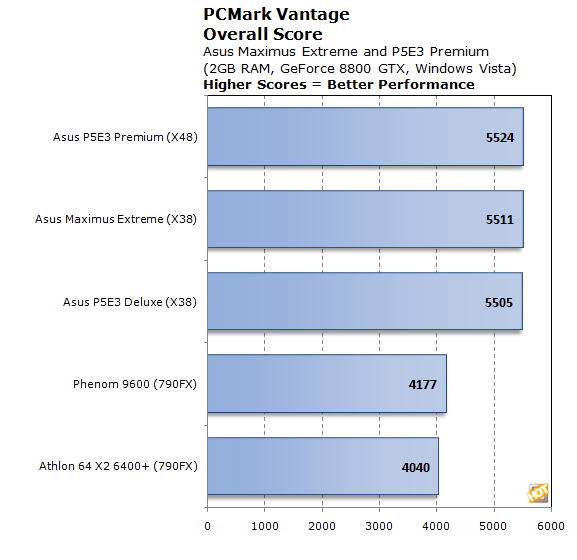Asus Maximus Extreme and P5E3 Premium
How we configured our test systems: When configuring our test systems for this article, we first entered their respective system BIOSes and set each board to its "Optimized" or "High performance Defaults". We then saved the settings, re-entered the BIOS and set memory timings for either DDR2-1066 (AMD) with 5,5,5,15 timings or DDR3-1333 with 7,7,7,20 timings (Intel). The hard drives were then formatted, and Windows Vista Ultimate was installed. When the Windows installation was complete, we updated the OS, and installed the drivers necessary for our components. Auto-Updating and Windows Defender were then disabled and we installed all of our benchmarking software, defragged the hard drives, and ran all of the tests.
![]()
HotHardware's Test Systems
Intel and AMD - Head To Head
|
System 1: Asus P5E3 Premium GeForce 8800 GTX WD740 "Raptor" HD Windows Vista Ultimate |
System 2:
Asus P5E3 Deluxe 2x1GB Corsair DDR3-1800 GeForce 8800 GTX WD740 "Raptor" HD Windows Vista Ultimate |
System 3:
2x1GB Corsair PC2-8500 GeForce 8800 GTX WD740 "Raptor" HD Windows Vista Ultimate |
|
For our first round of benchmarks, we ran all of the modules built into Futuremark's PCMark Vantage test suite. Vantage is a new benchmarking tool that we've incorporated into our arsenal of tests here at HotHardware. Here's how Futuremark positions their new benchmarking tool:
"The PCMark Suite is a collection of various single- and multi-threaded CPU, Graphics and HDD test sets with the focus on Windows Vista application tests. Tests have been selected to represent a subset of the individual Windows Vista Consumer scenarios. The PCMark Suite includes CPU, Graphics, Hard Disk Drive (HDD) and a subset of Consumer Suite tests."
The overall PCMark Vantage score is a weighted average of all of the modules in the Vantage suite calculated in total "PCMarks". Here are the results:
We tested all of the Intel-based motherboards represented here with a Core 2 Extreme QX9650 processor and 2GB of Corsair DDR3 RAM. The AMD powered systems were based on the recently released 790FX chipset and used 2GB of Corsair DDR2 RAM. Memories 1 - Two simultaneous threads, CPU image manipulation and HDD picture import If we tunnel deeper into PCMark Vantage's test suite, we see all of the Intel powered systems once again performing at nearly identical levels, which is to be expected considering we used the exact same CPU, RAM, and hard drive with each motherboard. TV and Movies 1 - Two simultaneous threads, Video transcoding: HD DVD to media server archive, Video playback: HD DVD w/ additional lower bitrate HD content from HDD, as downloaded from the net We saw more of the same from Vantage's 'TV and Movies' test. Gaming 1 - GPU game test PCMark Vantage's 'Gaming' test also reported similar performance from all three of the Intel-powered test systems.
According to PCMark Vantage, all three of the Intel-based systems performed at essentially the same level. The X48-based P5E3 Premium technically put up the best score, but the delta separating it from the Maximus Extreme and X38-based P5E3 Deluxe is minimal.
The PCMark Vantage "Memories" suite includes the following tests:
Memories 2 - Two simultaneous threads, GPU image manipulation and HDD video editing
Memories 3 - Video Transcoding: DV to portable device
Memories 4 - Video Transcoding: media server archive to portable device 
Vantage TV and Movies suite includes the following tests:
TV and Movies 2 - Two simultaneous threads, Video transcoding: HD DVD to media server archive, Video playback, HD MPEG-2: 19.39 Mbps terrestrial HDTV playback
TV and Movies 3 - HDD Media Center
TV and Movies 4 - Video transcoding: media server archive to portable device, Video playback, HD MPEG-2: 48 Mbps Blu-ray playback
Courtesy, Futuremark: "Gaming is one of the most popular forms of entertainment for all ages. Today’s games demand high performance graphics cards and CPUs to avoid delays and sluggish performance while playing. Loading screens in games are yesterday’s news. Streaming data from an HDD in games – such as Alan Wake™ – allows for massive worlds and riveting non-stop action. CPUs with many cores give a performance advantage to gamers in real-time strategy and massively multiplayer games. Gaming Suite includes the following tests: "
Gaming 2 - HDD: game HDD
Gaming 3 - Two simultaneous threads, CPU game test, Data decompression: level loading
Gaming 4 - Three simultaneous threads, GPU game test, CPU game test, HDD: game HDD 






